The 8 Identical-Artwork Pichu Cards from the English Expedition Base Set
Some of the rarest Pichu cards feature the Expedition Base Set artwork. This article explores what they are and how they came to be.
Table of Contents

Introduction
Released outside of Japan on 15th September 2002, one day before the Game Boy Advance e-Reader, Expedition Base Set was the first of the e-Card era sets to be released in English.
Made up of cards from Japan’s Base Expansion Pack (基本拡張パック) set and Pokémon-e Starter Deck (スターターパック) half deck, with 165 cards it was the largest Pokémon set to have been released at this time.
Including 32 holofoil rares and 40 non-holofoil rares, the set continued the concept of reverse holofoil cards introduced in the set’s English predecessor, Legendary Collection, but with a more refined design.
Along with the 165 regular cards to collect, 157 also included reverse holofoil variants, making the complete set consist of 322 cards in total.
The Regular Cards: #22 and #58
Similar to some of the earlier sets like Jungle and Fossil, all holofoil rare cards in Expedition Base Set have a non-holofoil version with separate numbering.
Pichu exists as holofoil rare 22/165 and non-holofoil rare 58/165.
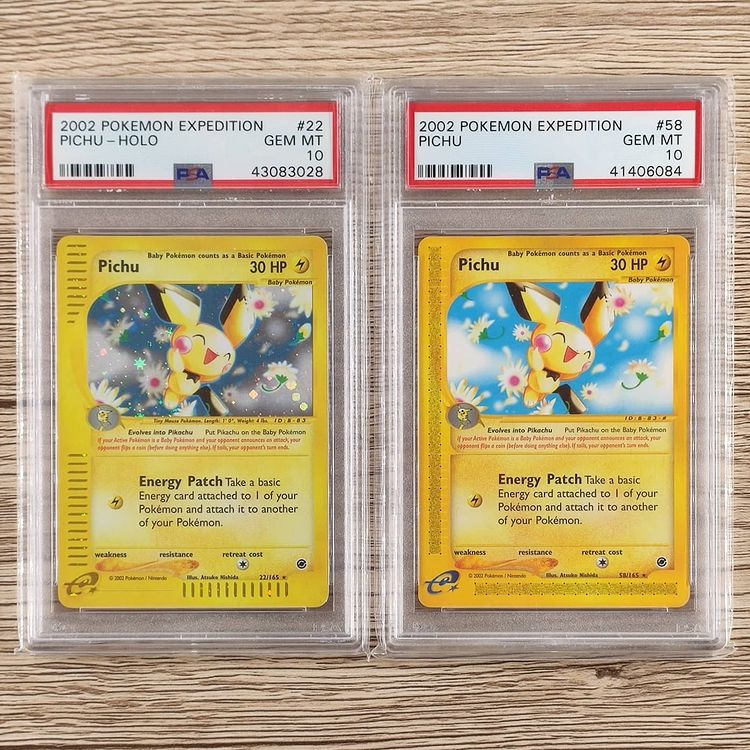
Differences Between Holofoil and Non-Holofoil
There are a couple of differences between the cards - other than the numbering and holofoil (or lack thereof):
- Only the non-holofoil card has the e-Reader dot code (the pattern used to identify the card when scanned through the e-Reader device) - the holofoil version instead uses a striped pattern which reveals the holofoil pattern below;
- The non-holofoil card uses the regular blue e-Reader logo whereas the holofoil version is a cut-out showing the holofoil pattern below;
- Only the holofoil version reveals the Pokémon’s stats below the artwork: “Tiny Mouse Pokémon. Length: 1′ 0″, Weight: 4 lbs.”;
- The card’s e-Reader ID is displayed as “ID : B - 83” on the holofoil card, whereas on the non-holofoil card it’s displayed as “ID : B - 83 - #”.
Regular Pull Rates
Where 1 in 3 Expedition Base Set packs contain a holofoil rare card and 32 varieties of such cards exist in the set, the chance of pulling a holofoil Pichu here is a meagre 1.04%. By comparison, with half as many holofoil cards in Base Set, the chance of pulling a Base Set Charizard is double that at 2.08%.
Every Expedition Base Set pack contains a non-holofoil rare card, and with 40 of such cards in the set the chance of pulling one of these non-holofoil Pichu cards is a more generous 2.5%.
The Reverse Holofoil Variants: #22 and #58
Though the number of cards in the set pales in comparison to some modern sets, at the time of its release it faced a fair amount of criticism for simply being too big.
The largest complaint people had was about the reverse holofoil cards: the identical-artwork holofoil and non-holofoil rare card both had their own reverse holofoil variants rather than having one shared between them. Not only did collectors have to track down a holofoil and non-holofoil rare card with the same artwork, but they also had to track down reverse holofoil versions of both if they wanted a complete set.
Wizards of the Coast did listen to these complaints and in the next set, Aquapolis, the holofoil rare cards had a separate numbering system - prefixed with a H - and only the non-holofoil versions had reverse holofoil variants.
Unfortunately this leaves Expedition Base Set collectors stuck with having to acquire two almost-identical cards.

Differences Between the Reverse Holofoil Cards
All of the differences between the regular holofoil and non-holofoil card from the previous section still apply to the two cards here, but now the artwork on the 22/165 card is no longer holofoil (as with all reverse holofoil versions of regular holofoil cards) and the dot code which is on the regular 58/165 card has now been replaced with a similar striped pattern on the 58/165 reverse holofoil card instead.
Reverse Holofoil Pull Rates
Unlike with the non-reverse holofoil versions, rarity does not affect reverse holofoil pull rates (a reverse holofoil common card has an equal chance of being pulled as a reverse holofoil rare card does). Because there are so many reverse holofoil cards in Expedition Base Set, the chance of pulling any specific reverse holofoil card is only 0.64%.
The E3 Expo 2002 Pichu
Between 22nd and 24th May 2002, E3 Expo 2002 was held at the Los Angeles Convention Center in California just short of five months before Expedition Base Set and the Game Boy Advance e-Reader launched in English.
Attendees who visited Nintendo’s booth at the event were given booster packs containing four e-Reader cards: a ‘Manhole’ card, a special Kirby card which could be traded in to win prizes, and early versions of Expedition Base Set’s 58/165 Pichu and 112/165 Hoppip.
Supposedly attendees were not allowed to take these cards out of the event, and certainly from my experience they very infrequently appear for sale. Because of this, the E3 Expo 2002 cards are very difficult to find.

Differences
This card is a slightly primitive version of what’s seen in the final release of the set in that it has 2 minor differences on the front: an e-Reader card identifier which isn’t prefixed with “ID:”, and the red text below the artwork appearing above the “Evolves into Pikachu” line.
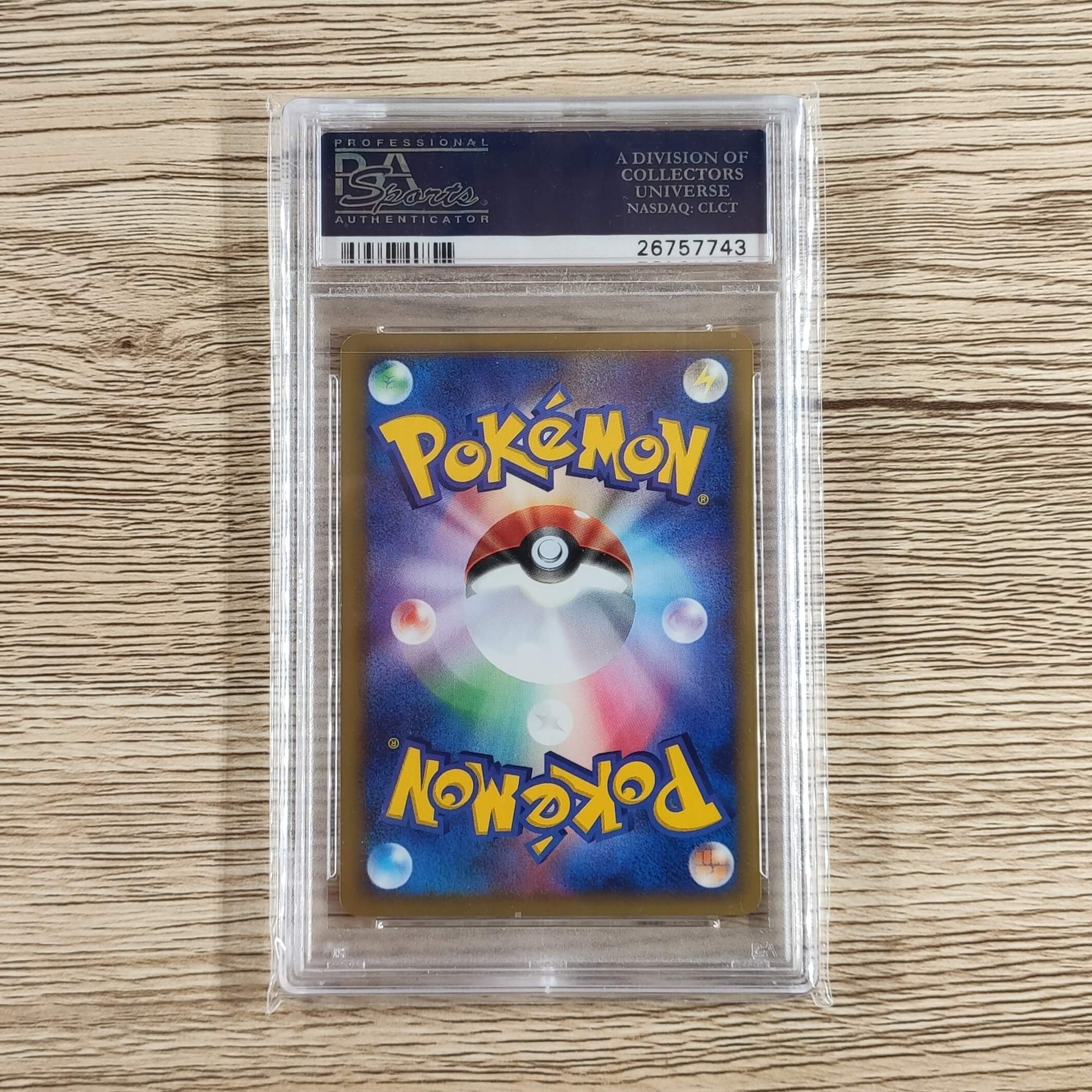
On the back, however, is the most notable difference: it uses the then-new Japanese card back instead of the usual English back.
I wonder if the plan was for English cards to also move over to the new Japanese back as well? I guess that’s something we’ll probably never know. At any rate, the final English release had the regular English back which remains unchanged to this day.
The Media Factory Sample Pichu
On 1st Decembmer 2001 - 10 months before the English release - the Game Boy Advance e-Reader was launched in Japan.
A Pokémon-branded Japanese e-Reader box was packaged alongside Application Pack (アプリケーションパック) - a set of 10 regular set cards from Japan’s Base Expansion Pack which could be used to unlock various games on the device.
Before the building was renamed to ‘Nintendo World’ and finally ‘Nintendo New York’, in August 2002 a press conference was held by Nintendo at New York Pokémon Center to demonstrate the upcoming English release of the e-Reader device.
Without going off on too much of a tangent, unlike the English cards which were printed by Wizards of the Coast, the company responsible for printing Pokémon cards in Japan at this time was Media Factory.
Supposedly unknown to Wizards of the Coast beforehand, and without permission to do so, Nintendo had shown up to the event with several English-translated versions of the Japanese Application Pack which had been printed by Media Factory.
Expedition Base Set was the third from final Pokémon set which Wizards of the Coast had a say in before Nintendo unilaterally took over in mid-2003.
In place of the regular Expedition Base Set logo was the word “Sample” and the 10 cards used a numbering system similar, but not identical, to the Japanese cards. They include 002/093 Hoppip, 004/093 Koffing, 016/093 Pikachu, 019/093 Gastly, 021/093 Machop, 042/093 Machoke, 048/093 Chansey, 074/093 Rapidash, 083/093 Pichu and 088/093 Machamp.
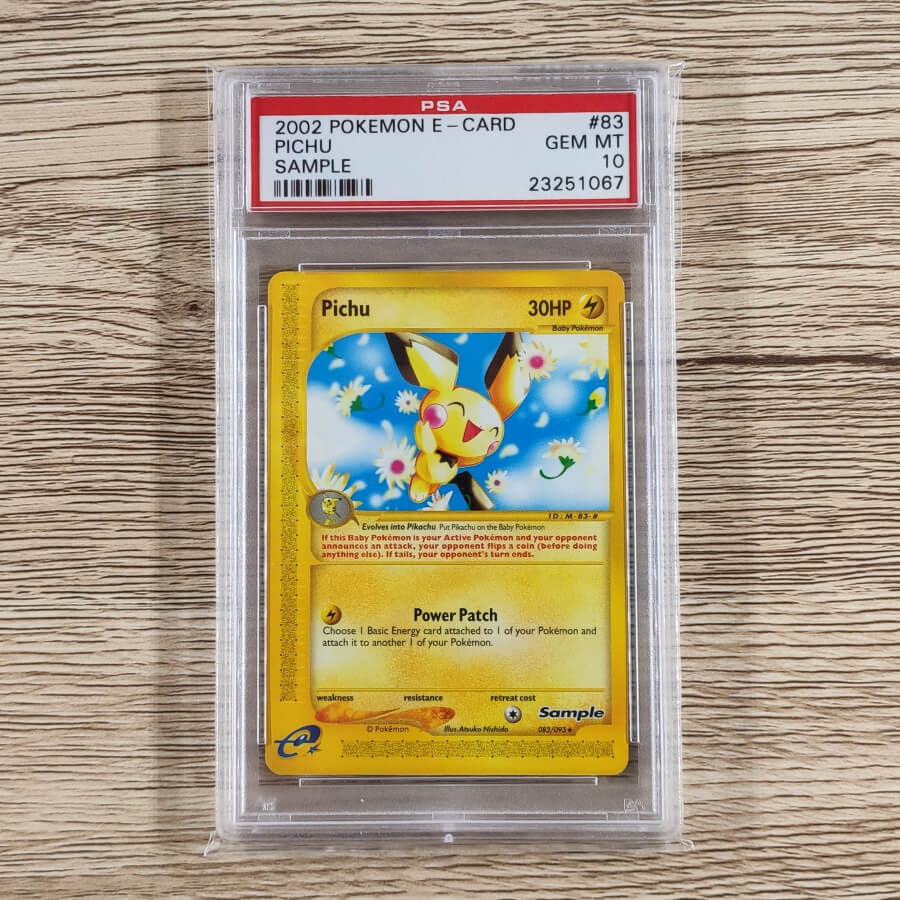
These cards were certainly not supposed to leave the press conference. With the exception of an even more primitive and very obscure sample Pichu card from E3 Expo 2001 which probably no longer exists (there’s a picture of that one on my Buylist), this is the rarest English Pichu card.
Differences
Where this is a rough word-for-word translation of a Japanese card, this card shares more similarities with the Japanese non-holofoil rare 082/128 Pichu than it does the final English release.
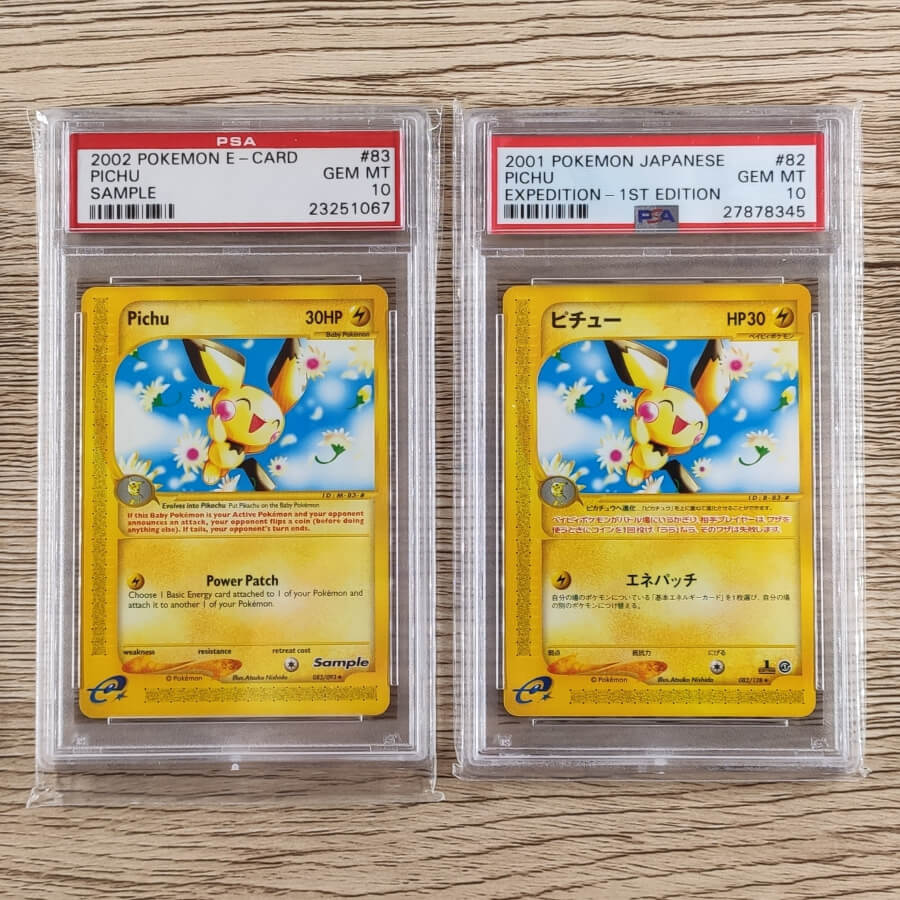
The other differences include:
- The word “Sample” replaces the Expedition Base Set logo;
- The card’s e-Reader ID is “M - 83 - #” instead of “B - 83 - #”.
- The card is numbered 083/093 instead of 58/165;
- Similar to the E3 Expo 2002 Pichu this also has a Japanese back.
Hole-Punched Store Demo Cards
To promote the newly-released Game Boy Advance e-Reader, special kiosks were distributed to video game stores across North America by Nintendo to allow customers to preview their functionality.
For customers to try the device without requiring staff assistance, a set of 3 cards consisting of Expedition Base Set’s 58/165 Pichu and 112/165 Hoppip alongside an e-Reader ‘Manhole’ card were attached to the kiosk via a metal cable threaded through a hole in each of the cards (presumably to prevent theft).
Along with this, a further set of 3 similar cards were also distributed to be attached to staff members’ lanyards, presumably so they could step in if the kiosk cards had been damaged or at stores which did not get a dedicated kiosk.
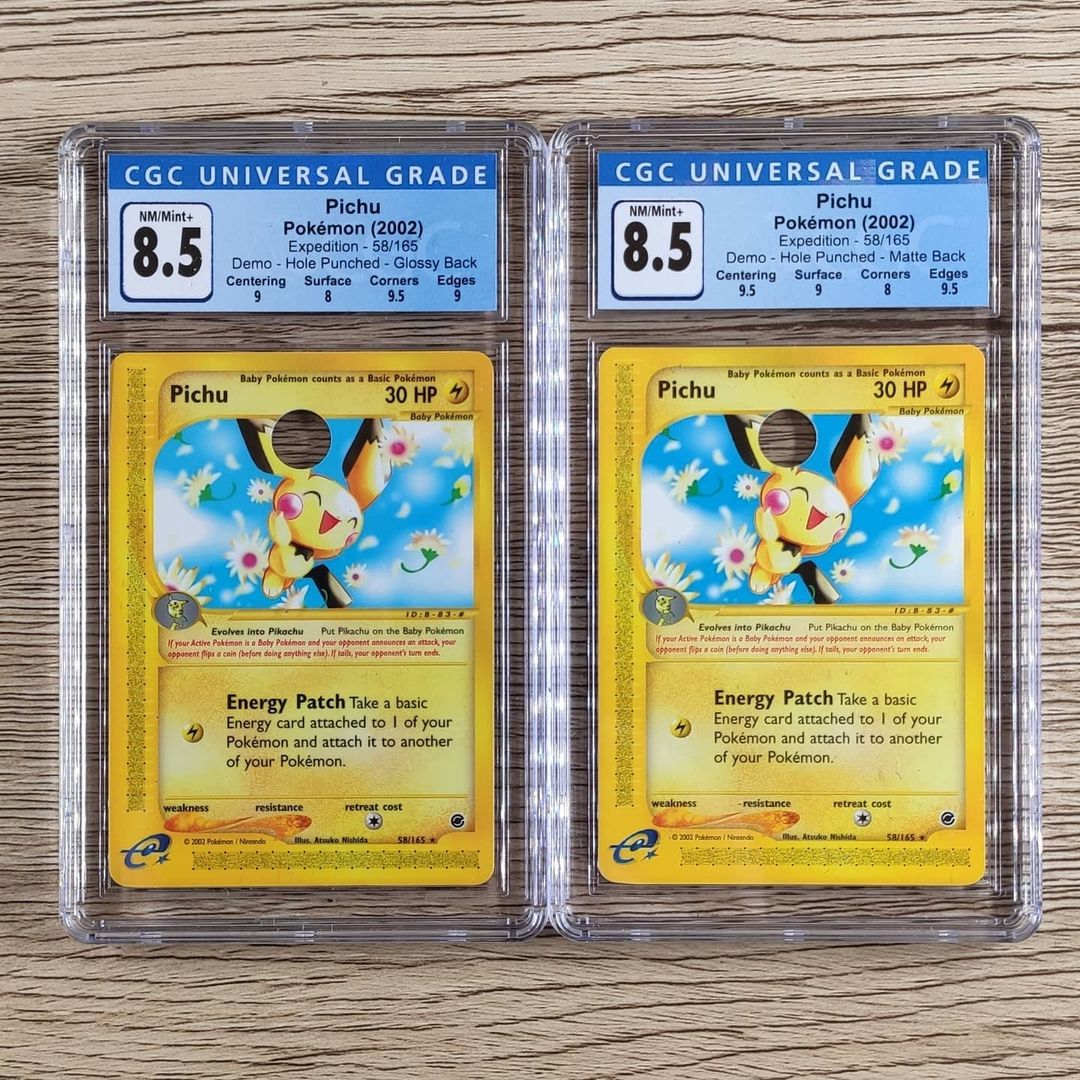
One of the sets has a thick glossy layer on both the front and back, whereas the other set only has a thin glossy layer on the front and a matte back. My guess would be the fully-glossy cards were the ones attached to the kiosk to prevent damage from constant use.
Unlike the previous two cards mentioned in this article, there have been an almost continuous supply of these hole-punched Pichu cards on eBay for the past 3 years which I can’t imagine will run out any time soon.
Differences
With the exception of the glossy texture - and the holes in the middle of both of them - this card is otherwise identical to the regular non-holofoil 58/165 Pichu card.
Game Boy Advance e-Reader Store Kiosk
Thanks to the preservation efforts of the team over at e-Reader Encyclopedia, a picture of one of these store kiosk set-ups still exists.[1]
The metal cable can be seen looping behind the “Slide It!” information board around through a Manhole card:

In September 2018 a former Nintendo employee who goes by the username singularphonez on eBay put up a listing for one of these devices without the information board. It shows a Pichu card attached to the device:
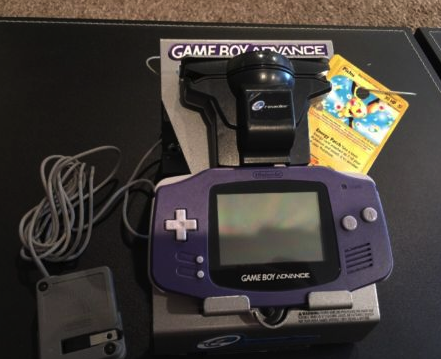
Conclusion
As a Pichu collector this artwork is something of a nuisance, but it’s also thankfully one of my favourites. I’m very happy to be in a position to fill this article up with pictures of cards from my own collection and I certainly do not envy anyone going after the E3 Expo and Sample Pichu cards today.
If it wasn’t enough that two very rare English cards use this artwork, one of the rarest Japanese Pichu cards also uses this artwork. I’ve written a separate article about that one and the set it belongs to if you’d like to read about it: Unlimited Japanese Pokémon-e Series 1.
This article isn’t perfect and to some extent was rushed. I’m hoping in time I can fully cite all of facts I’ve presented above. I’m keen to find out more about the press conference behind the ‘Sample Set’, and I’m hopeful a lanyard will show up for sale one day with one of the hole-punched demo cards attached to it.
Why do Pichu and Hoppip always appear together?
Scanning different cards through the e-Reader unlocks a variety of different games.
Pichu and Hoppip were the two cards required to unlock the ‘Hold Down Hoppip’ game, whereby players take control of Pichu and have to stop 5 Hoppip from flying too far away.
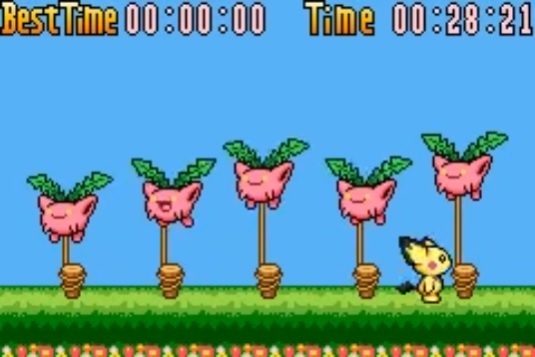
The aim of the game is to simply try to beat your own best time.
What about Matchprint cards?
This article focuses on cards which were publicly released or at least presented to the public in some way. Matchprint ‘cards’ are just internal design tests printed on essentially nothing more than proofing paper.
I have a separate article, Imation Matchprint™ Proofing Prints and why I’m No Longer Interested, which goes into more detail about what these are and how these came to be, and - as its title implies - why I’m not interested in them for my own collection.
e-Reader Card Preservation
A big movement is underway right now to preserve e-Reader cards.
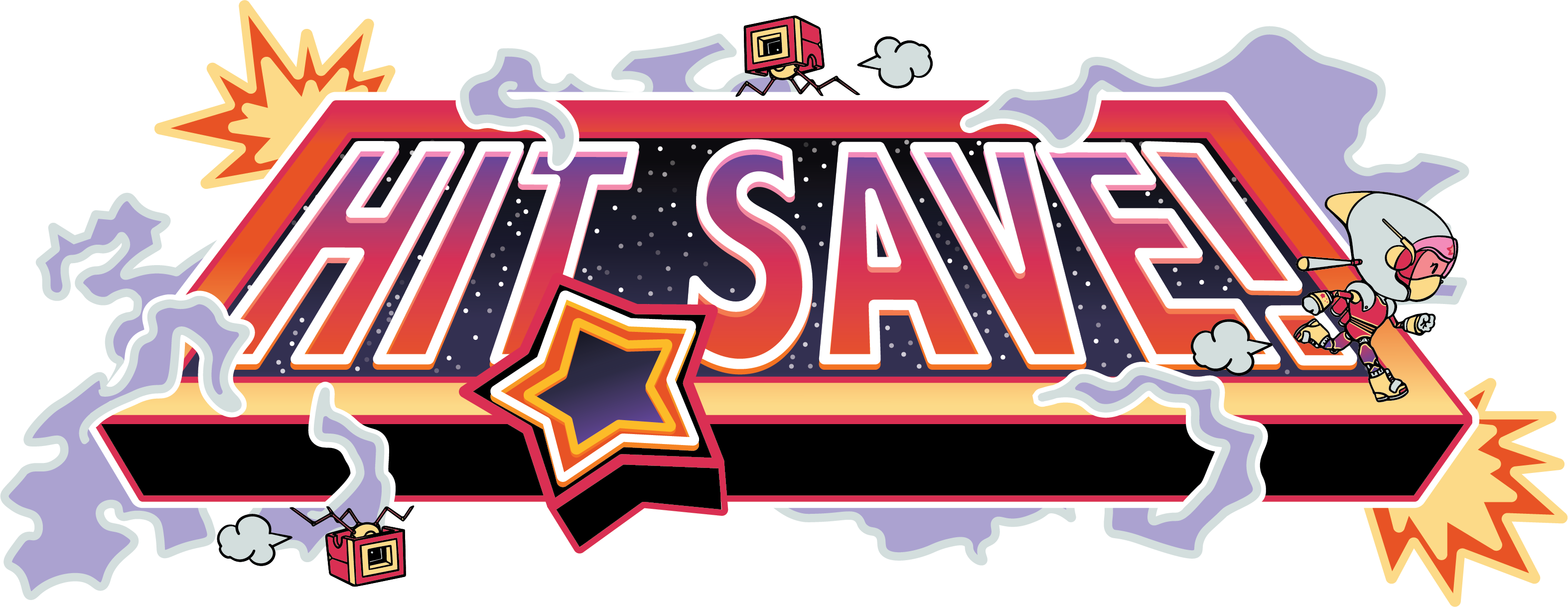
Hit Save recently completed a $3,000 fundraiser to catalogue and verify every e-Card in the Nintendo e-Reader library. They even have a functional prototype of a modified e-Reader device which can scan cards which are contained in top loaders and even graded cases.
If you want to find out more about the amazing work they’re doing, click on the links below:
They have a dedicated #e-reader-preservation channel on their Discord server - don’t be shy and come and join me in there! As a disclaimer, I am not affiliated with them but I am a big supporter of the work they’re doing.
References
- ereader.no-intro.org. 28th January 2020. e-Reader Encyclopedia カードe百科事典 - Resources (USA) [online] Available at: https://ereader.no-intro.org/info.php?set=Resources%20(USA) [Accessed 20th March 2020]